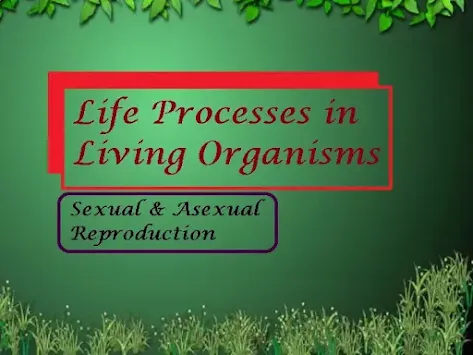 |
| Sexual and Asexual reproduction |
What are the main features of asexual reproduction?
- The process of formation of a new organism by the organism of the same species without the involvement of gametes is called Asexual reproduction. There is no involvement of the union of two different gametes.
- Exact genetic similarity: The new organism has an exact genetic similarity with the reproducing organism.
- Mitotic cell division: This is uniparental reproduction and it occurs by mitotic cell division.
- Absence of genetic recombination: The absence of genetic recombination is a drawback as the first process in advance in this reproductive method.
What are the types of asexual reproduction in the unicellular organism?
The various methods are used for asexual reproduction in unicellular organism they are following:
1) Binary fission:
Prokaryotes(Bacteria), protists(Amoeba, paramecium, euglena, etc.), and eukaryotic cell organelles like mitochondria and chloroplasts perform asexual reproduction by binary fission.
- Similar daughter cells: In this process, the parent cell divides into two similar daughter cells occur either by mitosis or mitosis.
- Favorable conditions: Binary fission is usually performed by living organisms during favorable conditions as the availability of abundant food material.
- There are three types of binary fission:
- Simple binary fission (amoeba).
- Transverse binary fission (paramecium).
- Longitudinal binary fission (euglena).
2) Multiple fission:
- Adverse condition: Amoeba stops the formation of pseudopodia and thereby movements whenever there is a lack of food or any other types of adverse condition.
- Cyst: Ameba becomes rounded and forms a protective layer around the plasma membrane. Such an encysted amoeba or any other protest is called a cyst.
- Repeated nuclear divisions: Many nuclear is formed by a repeated nuclear division in the cyst with cytoplasmic division and thus, many amoebbulae are formed. They remain encysted till adverse conditions and break open in favorable conditions to release the many amoebae.
3) Budding:
- Mitotic division: Yeast performing budding. Yeast cell produces two nuclei by mitotic division reproducing through budding.
- A Bud: A small bulge appears on the surface of parent cells. This bulge is called a bud. And one of the two daughters' nuclei enters this bud
- Live independently: Bud separates from the parent cell after sufficient growth and starts to live independently as a daughter East.
What are the types of asexual reproduction in multicellular organisms?
Various methods are used for asexual reproduction in multicellular organisms.
- Spirogyra and Sycon reproduce by fragmentation.
1) Fragmentation:
- Fragments: The body of the parent organism breaks up into many fragments and each fragment starts to live as an independent new organism as Algae like Spirogyra and Sponges like Sycon.
- Favorable conditions: whenever there is plenty of water and nutrients are available to Spirogyra, its filaments grow up very fastly and break up into many small fragments. Each fragment starts to live independently as a new spirogyra fiber. If the body of Sycon breaks up accidentally into many fragments each fragment develops into a new Sycon.
- Planaria is reproduced by regeneration.
2) Regeneration:
Breaks into two parts: Animals like planaria break up their body into two parts and thereafter each part regenerates the remaining part of the body and the two new planaria formed is called regeneration.
- Hydra is reproduced by budding.
3) Budding:
- A bud: a specific part of the hydra's body under favorable conditions outgrows by repeated divisions of regenerative cells of the body wall. This outgrowth is called a bud.
- A small hydra: Bud grows progressively and finally forms a small hydra with dermal layers and a digestive cavity.
- Nutrition supply: Hydra supplies nutrition to the budding hydra and when it has grown up and becomes able to lead an independent life, it separates from the parent hydra.
- Plant-like potato reproduced by vegetative propagation.
4) Vegetative propagation:
- Reproduction in plants with the help of vegetative parts like root, stem, leaf, and bud is called vegetative reproduction.
- Vegetative reproduction is performed in potatoes by eyes present on the tuber. Bryophyllum reproduces by buds present on the leaf margin. Sugarcane and grasses reproduce by buds present on nodes. Carrot and radish reproduce by roots.
- Fungus spores.
5) Spore formation:
- Filamentous body: Fungi like Mucor have a filamentous body. They have sporangia, once the spores are formed, sporangia burst and spores are released.
- Moist and warm place: Spores germinate in a moist and warm place and a new fungal colony is formed.
Sexual reproduction always occurs with the help of two germ cells.
Two main processes occur in sexual reproduction.
- Gamut Formation: gametes are formed by the meiosis process in which chromosome number is reduced to half and haploid gametes are formed.
- Fertilization: The union of haploid male and female gametes form a diploid zygote which is divided by mitosis and an embryo is formed. The embryo develops to form a new individual.
The new individual shows similarity with the parent. Give reason.
Two parents as male parents and female parents are involved in reproduction. Fusion of male gametes of the male parent and female gamete of a female parent occurs. Due to this new individual always has two recombination genes of both the parents. Hence, a new individual shows similarities with the parents.
How can plants and animals save themselves from being exterminated?
Diversity in living organisms could be seen due to genetic variation. Genetic variation helps the organism to adjust to the changing environment and thereby maintain its existence. Due to this, plants and animals can save themselves from being ruined.
I hope that this article satisfies your queries regarding asexual and sexual reproduction. If you have any queries regarding this, so comment, and whether it is important, then share with your friends. For further study, you click here.


